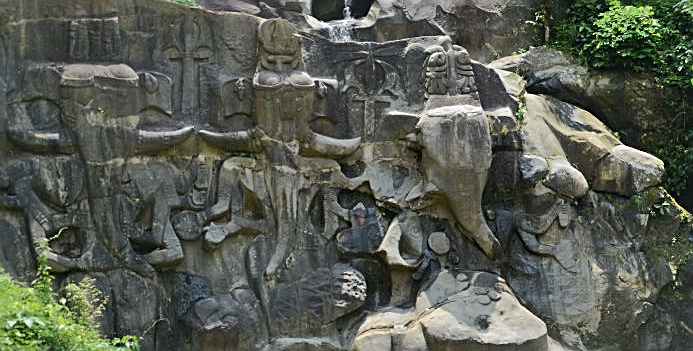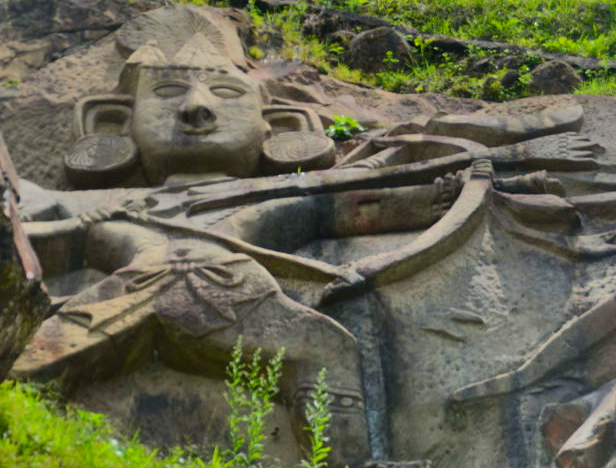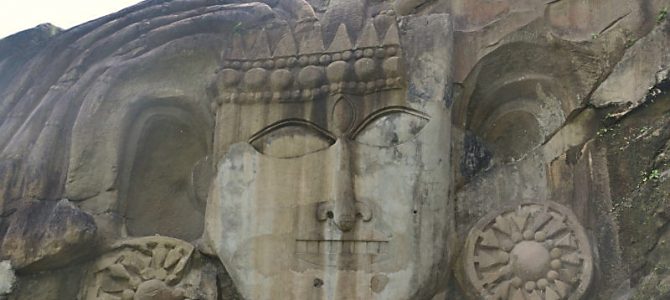Lord Shiva is a deity with many legends and folk tales. Lord Nataraja symbolises the cosmic dance. The Linga represents the physical structure most suited for storage of energy with little wastage. But the unique form of Shiva at Unakoti in Tripura is that of a tribal lord. Such representation is seen nowhere else. For a moment, Amish Tripathi‘s description of Shiva as a competent tribal warrior in his Shiva trilogy books rings true. The bas relief of Shiva, His family and other deities are carved on the natural contours of the rocks at Unakoti national park near the town of Kailashahar in the state of Tripura, very close to the border with Bangladesh.
Location of Unakoti
Unakoti is part of a national biodiversity park of the same name on a range of hills called the Unakoti hills in Tripura state. To the west and the north of the hills is Bangladesh. Unakoti is between the state capital Agartala and Dharmanagar on the Agartala – Dharmanagar – Karimganj highway. The nearest town with a post office and a bus terminal is Kailashahar. The road that splits from the highway and serves as the entrance to Unakoti park, ends at Kailashahar at the Indo-Bangladesh border fence.
What does Unakoti mean?
In Sanskrit and its derived languages, such as Bengali, which is the state language of Tripura, the sound Un or Una prefixed to a number means ‘one less than’. For example, unnees (nineteen) is one less than bees (twenty). Untees (twenty nine) is one less than tees (thirty) and so on. So Unakoti is one less than a koti or a crore. In western nomenclature, that would be a number just one short of ten million. The name talks about the number of deity sculptures carved on the rocks all over the park.
Important Sculptures
The main bas relief at Unakoti is Unakoteeshwara Kala Bhairav, a tribal form of Shiva about 30 feet in height. It is one of the biggest idols of Shiva in the country. There are several statues and bas relief carved in the adjacent landscape. Many are yet to be discovered, documented and opened to the public. What we see today is several digits short of the number Unakoti.
Statues of Goddess Durga and Ganga next to Lord Siva and the Ganesh sculptures can be seen as some of the most exquisite bas reliefs. Three Ganesh statues, a level below the main statue, are set against a small, but beautiful waterfall which drains itself into a pool in front of the statues. A unique feature is that Ganesha is shown as a lean deity with no pot- belly.

Ganesh statue at Unakoti
A small collection of various statues are displayed near an ashram at the corner of one of the hills. The Ashram also continues the consecration for the main Shiva statue. During monsoon, the beauty of the place is enhanced by the greenery and the waterfalls that fall on the bas reliefs.
Legend and Folklore of Unakoti
Dating of the sculptures varies widely based on sources. Official sources date it to 9 – 10th century AD during the Pala rule. There are several legends for the origin of Unakoti.
It is said that a local sculptor called Kallu Kumar wanted to accompany Shiva and Parvati to their heavenly abode at Mt.Kailash (tri-nation borders of India, Tibet, Nepal). Wary of the request, Shiva assigned Kumar the job of creating one crore sculptures by daybreak in return for his wish. Kumar fell short of his target by one.
Another legend says that the sculptor received a divine message in his dream to create the reliefs and went on to create sculptures of Gods and Goddess, their number amounting to one less than a crore. In the end, he created one last sculpture of himself rather than that of a deity. That sculpture is not regarded among the count and hence the name, Unakoti.

A bas relief showing Lord Ram and his weapon of choice.
Another folklore mentions that one crore deities including Lord Shiva were travelling to Kashi (Varanasi in Uttar Pradesh) and decided to rest overnight in the hills. He asked the deities to wake up and be ready to continue their trip by daybreak. But at daybreak, Shiva found himself to be the only one awake. In anger, He cursed all the other deities to turn into stones.
How to Reach and where to stay
Air
Agartala, the capital of Tripura, has the nearest airport and is about 178 Km away. An airport at Kailashahar, used by the army, is being converted into a commercial airport under the government’s Udaan project.
Rail
The nearest railway station is Kumarghat. All trains that are bound for Agartala, pass through Kumarghat. However, superfast trains like Tripura Rajdhani and Duronto do not halt at Kumarghat as they run non-stop from Silchar in Assam to Agartala. A train with more halts, such as the Lumding – Agartala passenger, is more useful.
Road
If travelling by road from the direction of Assam / Mizoram, then Dharmanagar or Kumarghat, both about 40 Km from Unakoti, are good places to stay. Dharmanagar is a beautiful place surrounding an artificial lake, with several lodges that overlook the lake. If you are flying to Agartala, a 3-hour journey in each direction gets you to Unakoti and back. Kailashahar is another good place to stay, but the town is on the side of Unakoti which is away from the highway. It doesn’t make sense to diverge so far off the highway just for accommodation.
Tripura’s roads have been revamped and are in excellent condition throughout the state. But the immediate area around Unakoti has no facilities, so take care of fuel and food inside the cities themselves, e.g. Agartala, Dharmanagar, Kailashahar or Kumarghat. The highway between Dharmanagar and Agartala, which leads to the road that faces the Unakoti entrance, has rolling hills and tropical forests. So it is a pleasure to drive.
Unakoti is open from sunrise to sunset. If you are planning a day trip and back, the best time to get there is as early as possible before the tourist crowd hits.
Conclusion
It’s not often that you see a depiction of deities in tribal form as huge bas reliefs on huge rock faces. So even though Unakoti is too far from the most important cities of India, it is well worth the visit. Don’t miss this unique man-made wonder of ancient India.

